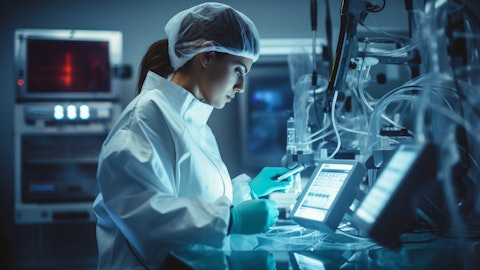Pat Mackin: Yes. I mean, I guess, if you think about it, we’ve got great channels. But this is a dynamic market, right? So just since our last call, we’ve released the post – the 5-year post-approval data for On-X, and we’ve released more data on AMDS, right? So that AMDS persevere data was in the quarter. It was at the end of January. So we’ve got great sales force, great products, but they’re being backed up by very strong clinical data. So everything that’s been coming out on the products has done nothing but reinforce and same with the Ross. There’s Ross data presented at AATS. It was one of the major focuses. And again, that’s growing very rapidly. So it’s really the combination, Suraj, proprietary product strong channels and really strong clinical data that just keeps coming out and all the products that we represent.
Suraj Kalia: Got it. Pat, one for you, one for Lance, and I’ll hop back in queue. In terms of additional opportunities, especially as I think about NEXUS app, love to get your updated thoughts. Lance, if I could quickly throw in there. I missed part of your commentary about the leverage, the SG&A in the quarter. Can you talk to about the sustainability? And also, is my math right that 23.5% seems to be the conversion price. How are you all thinking about ‘23 and beyond what happens to the conversion Gentlemen, congrats again. Thank you. Thank you for taking my questions.
Pat Mackin: Hey, thanks, Suraj. Yes, as far as NEXUS goes, I mean there’s been data – recent data was published at ATS – excuse me, STS on the TRIOMPHE trial. I think it was the first 20 out of the 60 in the pivotal arm – showed very strong results. They’ve now enrolled 44 out of the 60 that trial should enroll in the second half of this year. And it’s – the data looks very good. And again, you guys have been around a long time, particularly you Suraj, and you know how clinical trials go. But I think if you look at the data and the technology, that’s a meaningful space to be able to treat a chronic dissection or an aneurysm of the arch with a catheter is a unique opportunity. And that’s why we invested in the company, and that’s why we have an option to acquire. We are obviously going to be watching this as the trial enrolls and they get their data, but it looks promising. Lance, do you want to take the other two?
Lance Berry: Yes. So, on SG&A leverage, we think that’s a big opportunity for us going forward. We had really good leverage last year. We had a good start in, now 500 basis points is not something that we are committing to on a quarter-by-quarter basis. But you can really see when we have strong revenue growth, the leverage in the model, and I think that is a big opportunity for us going forward. On the convert, the 2,350 is when the convert is in the money, but we can’t force conversion unless the stock gets to $30, I think in some change, so just to be clear on that, where that is. And then as far as how we are thinking about it, I mean we talked about this on the Q4 call that, I mean the spread between the interest – the cash interest we are paying on these converts versus the delayed draw term loan is pretty significant.
And at the moment, we are just happy to pay the lower interest. And I think we would probably all hope that interest rates wouldn’t have maybe started to come down by now, but that’s not the case. So, we are just watching it and we will keep keeping our options open on what to do on that.
Operator: Our next question is from Rick Wise with Stifel. Please proceed.
Unidentified Analyst: Hey Pat. Hey Lance, this is John on for Rick this quarter, really strong growth on the top line. I just wanted to maybe start off on the On-X data that recently read out at AATS as you highlighted, really strong. I just want to hear it maybe from more of a market perspective. How much share do you see as left to go for On-X to take in the mechanical space? And beyond that, what you see as the opportunity for the valve to potentially reach the bioprosthetic market?
Pat Mackin: Yes. So, on the pure mechanical market, the global data we have, we got about a 30% share globally. It’s higher in the U.S. It’s more like 50% plus in the U.S. than it is outside the U.S. So, we have a lot of room to go outside the U.S. I mean I have heard comments from surgeons when we have talked to them about this data – about even competitive accounts, like why would anybody use another valve. So, our team is very fired up about going aggressively after this mechanical valve market. As far as the Bioprosthetic segment, typically in patients under 65 years old, there are certainly some signals there that this data can go after bioprosthetic, but I am not going to get out over my skis here. This data just got released. And we are going to be exploring that. But for right now, we are going aggressively after the Mechanical segment when we still have a lot of room to go.
Unidentified Analyst: Thanks. That’s helpful. And if I could sneak in sort of a two-part here made the first for Pat, the second for Lance. Just on the aortic side of the business, growth was really strong this quarter. I think it came in at kind of mid-20s. I just want to get a sense from you what the key growth contributors are and how you are looking at growth for the aortic business for the rest of the year? And then second for Lance, just on the gross margin profile, tissue was particularly strong, near 60%. Just how are you thinking about tissue gross margin for the rest of the year and gross margin for the business as a whole? Thanks.



